CHINA
Beijing historical experiences
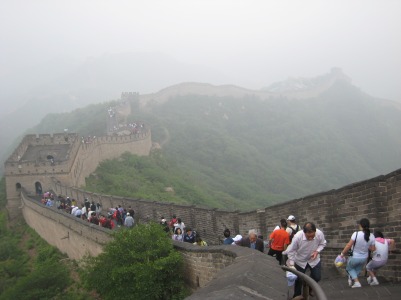
The Great Wall
Driving to the outskirts of Beijing , I held my breath as I realized what I was about to see. The Great Wall, a symbol of Chinese unity and power begun back in the seventh century B.C. and which took more than 2 millennia to build, was to be approachable. I would be able to scale its walls and touch the very wonder that is the Wall. As we piled out of our bus, the noticeable chill of the air made itself very apparent. We were in mountain country now, and the realization that this extensive architectural achievement had to be built on mountains of such height and steepness simply added to a burgeoning sense of amazement. Before we began our climb, in a sort of tongue in cheek mood we bought jackets that stated proudly “I have climbed the Great Wall”. And so, our climb began. Unfortunately for us the wall was absolutely swarming with people and almost 100% of them had a camera or two hanging around their necks. But even the crowds couldn’t dampen the feelings of excitement and awe. The top of the wall sloped up and down following the shape of the mountains, and according to our guide the wall was more than 6000 km in length. The effort it took, however, to walk even perhaps 1 km on the wall was quite tiring and I couldn’t help but marvel at the amazing legs ancient Chinese warriors must have had. The Great Wall has been a symbol of Chinese pride for a long time, and recently it has been named one of the seven wonders of the new world. But the wall is also known as the largest tomb in the entire world, we were told several stories about those who died building the Great Wall. The amount of lives and work put into the wall lays a testament to the power of the past emperors. After taking countless pictures and meeting many street vendors trying to get us to purchase items with the ubiquitous motto “You are not a hero till you climb the Great Wall” in the words of Chairman Mao. Climbing back down, I couldn’t help but feel slightly sad. I wished we could have stayed a few more hours, and perhaps gone farther down to another area of the Great Wall that was far less touristy but just as beautiful.
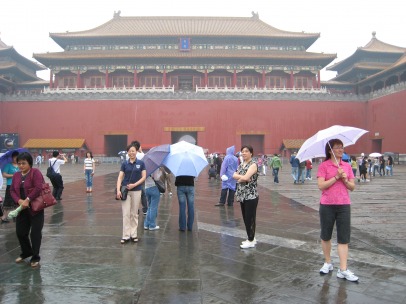
The Forbidden City
In Beijing , the greatest and most extensive symbol of past emperors’ grandeur and power would undoubtedly be the Palace Museum , formerly known as the Forbidden City . Construction began in 1420 with Ming emperor Zhu Di, and the last emperor to stay there was Pu Yi in 1924. As we approached the imposing Meridian Gate, which was the only entrance into the Forbidden City , rain began to fall simply adding to the feeling of grandeur and a small thought in the back of my brain that perhaps I didn’t belong there. The Gate was amazingly large with 5 doorways, a huge one in the middle for the emperor, and the rest for family members and officials of varying ranks. The inner sanctum was fantastic. The first thing one was exposed to was the five bridges made out of white stone which served a similar purpose to the five door ways and took entrees over the river of “golden water”, supposedly made of all 5 elements of the universe. The buildings inside were massive. I was slightly put out when I discovered the largest and most magnificent of the buildings, the Hall of Supreme Harmony, was under construction. But we continued on and we were able to see many buildings of varying importance but all amazing. At the front gate we had purchased an audio tour device that would react to the location and tell me about the place I was at, and as I passed through the area exploring, I would often stop and listen to the lightly accented English at my ear trying to teach me about the wonder that is the Forbidden City . Scampering through the rain, thronging crowds, and wet stone a desire to have been here back in the time of the emperors manifested itself in me. The importance of what we were seeing, from the fact that this complex was the imperial headquarters to the important religious implications tied with the Temple of Heaven (see below for explanation) made this a very special visit. Of everything in Beijing , except the Great Wall, this was the most fascinating and undoubtedly the most educational.
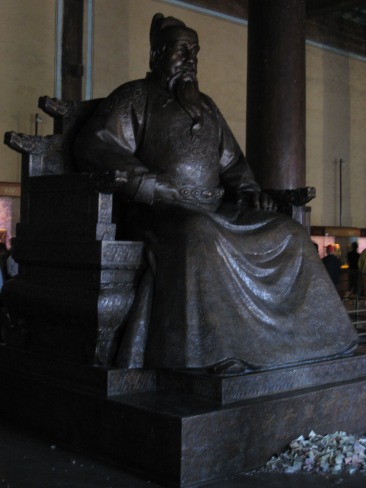
The Ming Tombs
Reportedly begun after the death of 3 Ming emperors, and beginning with Zhu Di (in 1420, just like the Forbidden city ) who began the Forbidden City , the tombs are magnificent. We were only able to see one, because one can dedicate several hours to a single tomb, and so more than one couldn’t possibly fit in our schedule. We went to the building right near the tomb. The actual tomb containing the body of the emperor and his main wife is kept under a great mound of earth and so one can’t see them but the building was supposedly lucky, but also not in the realm of the living. In order to get back and look at other things in the area, we had to run over a step and say in mandarin “return from where you came” or Hwei To Lu. The complex had a lot of artifacts as well as several grand buildings in the area to commemorate the emperor and bring luck to him and his family. We were able to see many interesting things such as the empress’ thousand child robe (in order to encourage procreation, an embroidered robe with literally one thousand kids on it was given as a wedding present) and several examples of emperor head gear from a more casual sort of crown to a special war helmet. Not only did they have these artifacts, but they also had a magnificent and huge bronze sculpture of the emperor whose tomb we visited, sitting upon a bronze throne and looking very wise and brave.

Temple of Heaven
This site in Beijing was a particularly fascinating one to arrive at. It had a similar vibe to the Forbidden City upon entrance, a feeling of wariness and lack of belonging. However, unlike the Forbidden City there was a lot more activity going on inside the Temple of Heaven to the point where if you go in far enough it seems like a regular hangout. There were people singing, playing a game that looked a lot like hacky sack, and other interesting pastimes. Not to mention there was ice cream being sold, of which we bought some. The Temple of Heaven began construction in 1420 (yup, just like the Ming Tombs and the Forbidden City ) and was used as a place to do imperial sacrifices and an important part of the Tao religion. The main reason for the Temple of Heaven was for an annual ritual of the emperor to come pray for a bumper harvest. There are two parts of the complex, the part that is still of this earth, and a part that is of Heaven. When crossing into heaven, there is a long road one must walk, and the walkway is a simple road with a drop on each side, and is paved with two colors of stone: dark gray and white. The white is what one is supposed to walk upon, and in a similar manner to the Forbidden City gates, there are 5 walkways. The main difference was that the middle path was reserved for God, the emperor had one near the middle, than important family members, officials etc. (women weren’t allowed in the area, so no need for something special for the empress). While walking down the middle path, one can’t help but feel a sense of glee; walking in the footsteps of a god and in a place where the emperor wasn’t allowed is a very notable accomplishment in my mind. The Heaven area of the complex had the actual Temple of Good Harvests and a few lesser ones. There was also an amazing altar near the end called the Heaven Worshiping Altar. Just walking on it felt lucky, what with its architectural use of the number 9 and 24 (both lucky in some way or other) and purely made of white stone. Exiting the area and coming back to “Earth” felt in a way odd: it was as if I truly made a transition. With one last glance at the altar, we left behind a place of the Tao gods.
Cultural Experiences
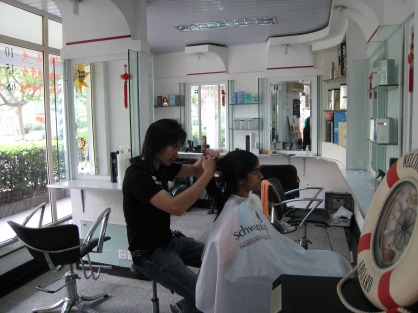
Getting a haircut
A seemingly normal thing to do can be quite abnormal when you are in a different country. Getting a haircut was no exception. When we walked into the doors of the hair parlor, I surveyed the shop. The shop looked very clean, had lots of bright lights and 3 hairstylists on duty (all male) and a woman who seemed to be the one in charge. To start things off, I was taken to the room farthest in the shop and was given a shampoo, which not only felt really nice but afterwards they wrapped up my hair in a very funny looking way using an orange towel. My mother then proceeded to try and explain what she wanted done with my hair to Melody, who in turn tried to explain it in Chinese to the hairstylist. And then he began, methodically cutting and trimming my hair, and later thinning it. It took more than 2 hours to complete my haircut, and in the same time another hairstylist was able to get through about 3 customers. Also, something was lost in translation and the hairstyle I was sporting was definitely not what my mother wanted. As a testament to my hairstylist’s skill, it was a nice cut, but my mom got very angry and instead of getting her haircut here (we were short on time too…) she decided to take her business elsewhere. But I did enjoy the experience for the most part. I was very amused to here interspersed between the large volume of Chinese pop music, they had a Backstreet Boys song or two. My sister and I looked distinctively changed when we exited the shop, and for the most part we were very happy.

A massage!
We were striding down the sidewalk going to Melody’s mum’s house when we passed the massage parlor. We saw a sign on the outside which basically said that if you came in before 5 (p.m. mind you) one could get an hour-long foot massage for only 25 yuan (or about 3.50 dollars). And, as a result, my parents allowed me and my sister to go get one! It was absolutely wonderful, not only do they massage your feet but they massage your arms, neck and back as well; it was an enjoyable experience to say the least. They also bring hot tea and wash your feet, and I must say for an hour of heaven $3.50 is most obviously worth it! I was very pleased when my parents allowed me to go a second time, and I am still amazed at the degree of skill these masseuses had. My parents went in for full body massages, and both of them came back feeling much more limber and better about themselves.
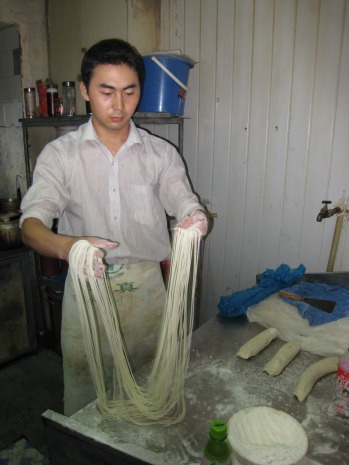
Noodle shop!
When in the United States and one goes out to dinner, the restaurants are usually set up in similar ways, a bunch of tables kept in a room with some type of décor, and the chefs nowhere in sight. The exception to the rule would be the family restaurant, and it is in the family restaurant where one usually gets the most out of an experience; more culture and better food. As a result, it was very exciting when my family was taken to a small family restaurant which doesn’t even have a name. We call it the Uighur noodle shop. The shop was owned by a family of Muslim Chinese, or Uighurs who made noodles right in front of your face. We ate noodles soon afterwards and it was absolutely wonderful. Since there was such a large group of us (there were 11 of us) we were ushered into the relative privacy of the upstairs level. It was a small cramped room that barely fit all of us but regardless of how gray the walls or the lack of fancy décor, it was clean and somewhat home-like. Eating the hot spicy noodles in such an environment I had the uncanny feeling that this could easily become my favorite restaurant.
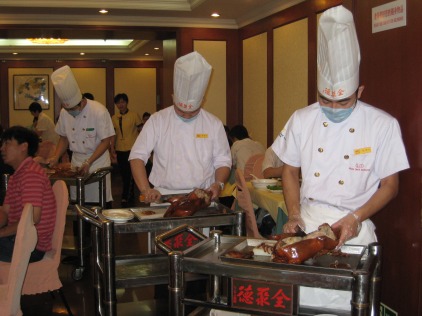
Fancy restaurants
In the United States , fancy restaurants are notable for their impeccable décor and their gourmet food. However, regardless of how upscale and fancy these restaurants are, the “fancy” restaurants of China have them beat. Most of them are many, many times bigger with several stories and ridiculously expensive décor. For example, the bathroom of the best one we went to was so extravagant I felt nervous about using it. Each cubicle in the bathroom had a crystal ash tray and a porcelain vase, and I could not help but feel that it was so wasteful… no one is going to be looking at the vase, in fact it was behind the toilet! It was rather funny though, when walking inside one of the particularly nice ones, there was very fancy looking furniture and objects around the area, but some of the furniture one wasn’t allowed to sit on! I remember feeling very underdressed every time I went to one of these restaurants. Because we were always going around with a group of 10, 11 or occasionally 12 people we were always given our own room and usually two or three waiters at our disposal. It’s times like these one can’t help but feel slightly grateful for the low rate of human labor.
Factory
When going to a foreign country, or at least when going to a foreign country with my dad, there is an unspoken goal: we must experience as much culture as possible. As a result my father in conjecture with Yi found away to arrange for a factory visit! And as China has become the unofficial manufacturing center of the world, it seemed rather fitting to go to a factory. We were escorted by the owner of the factory and the company who runs it, Peter, who is a good friend of Yi’s and lives in Houston . His factory has a main business of producing sensors (they are the second largest company in the industry with revenue of over $12 million a year) though on the side they also produce plastic parts and molds. The company is called Analytical Sensors & Instruments Ltd and was started in 1988 by Peter Cai and his wife Yuxian; the only two employees at the time. Now the employee count is over 200 and it is a successful company that has several important contracts with companies such as Vernier (produces science supplies) and EcoLab (a lot of pH sensors and such). The company employs many designers and workers, but his factory in China gives him a large advantage over his competitors due to the low labor costs. Peter Cai was originally CEO of the company, though he retired from the position as of 2/27/07 . Now he is chairman of the board and a CFO. His China factory is called Aurora , and is doing very well. One of the main benefits that China has to offer other than the low labor costs and low price of many goods, is the very well established infrastructure. They have round the clock electricity which makes China better for manufacturing (Peter’s factory has no backup generator), and gives it a major boost over countries such as India . After we left the factory he told us much about how a lot of hard work was put into starting the company and as a result, the core technology remains only in the family.

School
We visited a Chinese middle and high school called Tongjidaxuedierfushuzhongxue. We were shown around by Mr. Zhang, the academic director, who did a very good job of giving us a taste of how the school operates. It was kind of funny walking through the halls, every single person who saw us pretty much stared at us as if we were some kind of monkey. But the interesting part lies in the quality and the manner the school is run compared to Westwood. The very environment was different and one could literally feel that the Chinese school had a more intellectual and focused manner about it. One can see this from the minute one walks in. The entrance had 12 brightly colored flags with advice, and more of this sort of thing was put all around the school. Also there is a whole floor dedicated to science labs and they have many computers available. The government provides a lot of money to the school making it free for most students. As far as average high school problems such as pregnancy and drugs, we discovered to our delight that it was nearly non existent. The main problem was due to stress because one big test decides which colleges you can get into, so occasionally a student becomes overstressed to the point it is medically dangerous. We also found out the school was affiliated with Tongjie University and as a result, the faculty of Tongjie University help influence the curricula of the school and often a professor will come and work with the high school students. As far as the actual facilities, the school was very nice and clean and looked very good. They had a bike parking garage for students (they aren’t expected to be driving around, in fact that is uncommon) and several relaxing areas with a piano and art arranged tastefully around the room. In the school’s art classes a lot of traditional arts are done such as the paper cutting, calligraphy and traditional Chinese painting. There are also western art forms but those are not seen much on the walls of the school. There are also areas dedicated to great men, such as Rabindranath Tagore, William Shakespeare, Frederic Chopin, Vladimir Lenin, Joseph Stalin, and of course Mao Zedong and Dr. Sun Yat-Sen
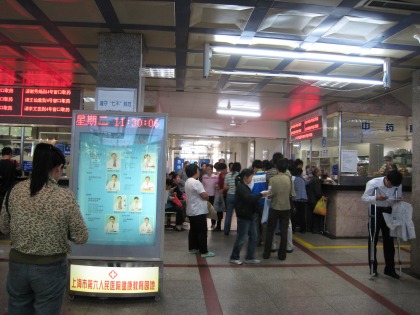
Hospital
As part of our cultural excursions in China , we visited the Shanghai Sixth People’s Hospital, well known for its orthopedics and ultrasounds in the area. The hospital was not remarkably different from an American one by sight, until we reached the end of one of the long corridors. A glass door was in front of us, and behind it a beautiful and brightly illuminated ward could be seen. We turned to the administrative director who was giving us a tour to discover the purpose of this ward… and we found out the truth. One of the bonuses of being a high-ranking communist party official was exclusive and high quality treatment in a special area marked only for these A-level officials. It was impossible not to see the contrast between the special ward and the rest of the hospital, and it was obvious from our guide’s expression and posture that he wanted to lead us away from this part of the hospital as soon as possible. However in general the hospital was a good quality one with a lot of capacity and, according to the patients we had a chance to talk to, relatively cheap.
Safety
The relative safety of Shanghai was also a welcome surprise. Even at night, the brightly lit street of Shanghai has all sorts of people walking around, like a couple of giggly college girls to a group of old men playing a variation of Go; none of them afraid of getting mugged or anything of that kind. That is not to say there are no dangerous situations; there is a thriving illegal goods trade that can be potentially risky getting involved in but for the most part the streets are much safer than take for example New York .
